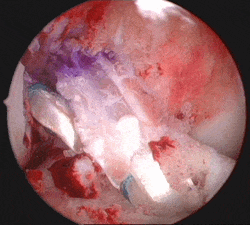ACL reconstruction is performed by placing a tubular graft (measuring about 8 to 10 mm in diameter) through 1 tunnel drilled in the femur (thigh bone) and 1 tunnel drilled in the tibia (leg bone). However, the natural shape of a normal ACL is not a tube at all. In fact, it is shaped more like a fan, or a ribbon twisting 90 degrees from thigh bone to leg bone attachment. Each side of this fan has a slightly different function in controlling normal knee stability, and the attachments sites on the femur and the tibia are oval in shape, and around 14-18 mm wide.
In the 1990s, the traditional position of the tunnel on the femur (thigh bone) was high up close to the "12 noon" position, at the extreme edge of the ACL attachment site. This is now referred to as "non-anatomic single bundle ACL reconstruction". With the recognition that the original femoral tunnel might be "too high", researchers increasingly showed that the "non-anatomic single bundle" technique was not controlling rotation as well as it was controlling forward motion, and this was believed to be the reason for some patients not getting back to sport.
As a result, "Double-bundle ACL reconstruction" involves drilling 2 holes in the femur (thigh bone) and 2 holes in the tibia (leg bone) to try to better reproduce the normal ACL. However, the technique of single bundle ACL reconstruction also changed. Since 2000, most surgeons performing "single bundle ACL" have moved the femoral tunnel position downwards, to the centre of the fan shaped attachment site on the femur (thigh bone). This is known as "anatomic single bundle ACL reconstruction".


Double bundle ACL reconstructions have been shown to be "better" than non-anatomic single bundle ACL reconstructions, but have not been shown to "be better" than modern anatomic single bundle ACL reconstruction technique. As such, most surgeons worldwide have still not adopted double bundle ACL reconstruction as a routine technique. This is especially since double-bundle ACL reconstruction takes slightly longer to perform, may require extra graft tissue, and may have a slightly higher pain and risk of complications with the need to drill 2 extra tunnels in the bones.
As such, we recommend double-bundle ACL reconstruction only in certain groups of patients, specifically patients who are taller than 1.8 metres in height, or have specific sports demands that might require it. Deciding on the technique of ACL reconstruction is something that requires detailed discussion with your surgeon.
